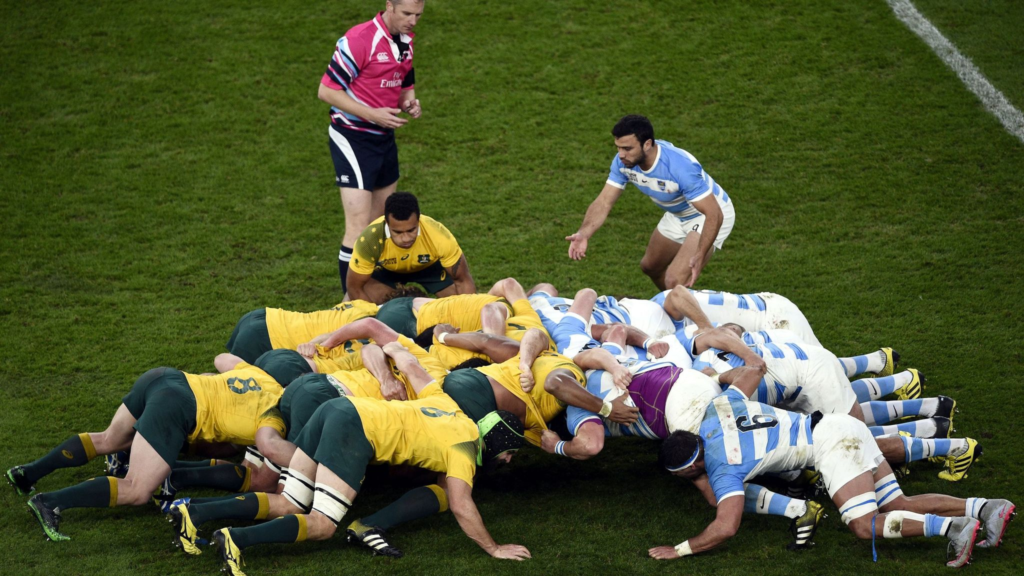If you ever happen to attend a rugby match or watch one on your TV, chances are you’re likely to witness a scrum or two. As a matter of fact, you are guaranteed to see several throughout the course of play since they are as much a part of the game as the ball itself or the players from the two teams. Their frequency often leaves fans wondering whether scrums are the game’s go-to dispute resolution mechanism, and though there is some truth to that sentiment, there are actually specific instances where a scrum is the only avenue for recourse and others where it is merely one in a list of possible remedies.
When is a scrum awarded in rugby? A scrum is awarded in Rugby to restart play after a stoppage or a minor infringement like a knock-on, a forward pass, or when an unsuccessful maul or ruck results in broken play. Teams may also opt for a scrum instead of taking a penalty in instances where an infraction by the opposing team results in them being awarded one. It is however also important to note that scrums may be formed to resume play even when neither team is at fault.

What Is a Scrum?
As was previously mentioned, a scrum, which is short for a scrummage, is a way of resuming play once a minor infraction or stoppage occurs during a match. The logic behind it is quite simple – to concentrate all the attacking players (forwards and scrum-halves) within one locale of the field and subsequently open up the rest of the field for the backs to martial a charge/attack thus continuing play.
Since scrums are constituted to continue broken plays (where neither team commits an infraction), their objective is to be fair and to afford either team the opportunity to capitalize and make something out of the resulting play.
In as much as a scrum is intended to ensure a certain degree of fairness, some teams are known to prefer using them as a statement – to exert physical and psychological dominance on their opponents as the game is played on both these fronts. A team may also opt to take the indirect route and use a scrum as a sort of tactical retreat to give their defense an opportunity to reset and brace itself from an attack in instances where any other alternative may have resulted in their opponents scoring a try.
How and Where Are Scrums Formed, and By Whom?
A scrum is formed at the area that a referee points to in accordance with the provisions laid out in Law 19of the Laws of the Game. In the rugby union (15-a-side), a scrum consists of eight players from both teams.
The scrum players are as follows: two props (tighthead prop and loosehead prop) and a hooker on the front row, two locks (who reinforce the front row) on the second row, two flankers (openside flanker and blindside flanker) who position themselves on either side of the locks, and a number 8 who is positioned behind the two locks.
Every player in a scrum plays a specific role. The two props in the front row are tasked with being the front line of offense and defense – to push and equally resist the pushing of their opponents and to stabilize the hooker whose main responsibility is to content for the ball after it is introduced into the scrum.
The two locks that bind to the spaces between the props and the hooker are given that designation because their primary responsibility is to “lock” their side of the scrum in place in order to prevent it from prematurely collapsing once it comes under pressure from their opponents.
Flankers play both an offensive and defensive role. They partially bind to the locks in order to further reinforce the scrum and watch for reactions from their opponents in readiness to thwart any resulting attacks. Their positioning helps since most of the other players in the scrum are mainly concerned with piling pressure on their opponents such that they may not be aware of developments on their opponents’ end.
Being positioned on the third row, the number 8 is tasked with controlling and directing the forwards who are involved in a scrum from behind. They are allowed to pick up the ball using their hands though it is ideally preferred that they first control the ball with their foot before attempting to pick it up.
The Various Reasons for Scrums
There are specific instances where a referee almost always calls for a scrum. They are:
- When an injury occurs to a player on the field forcing the referee to stop play
This reason is self-explanatory. Among the referee’s duties is to ensure the safety of players. In case of an injury, it is most desirable that the action continues away from the downed player. Since the referee is often in the thick of the action, a medical observer who is strategically positioned on the field may signal to him in case a player needs medical attention.
Where play has to be stopped, the team with the possession of the ball prior to the stoppage is awarded the scrum. A scrum comes in handy in such situations as it helps avoid unnecessary entanglements or collisions between players (injured or otherwise) and medics which may result in more injuries.
- Knock-ons
Simply put knock-ons are instances where the ball illegally advances forward. They may be deliberate or accidental. The phrase “intent is 9/10 of the law” applies here and it’s normally up to the referee to decide the proper course of action.
A knock-on may result from instances as simple as a player fumbling the ball forward or as complex as cases where a player drops a high ball. A scrum in this case is ideal since it gives a team possession of the ball in an advanced position.
- Broken Plays
A referee may also award a scrum in situations where players fail to execute certain aspects of the game correctly. They include where quick throws are done incorrectly, where the ball becomes unplayable in mauls and rucks and where a team messes up a restart or a kick-off.
If a player messes up at the lineout by dropping a ball or a player carries the ball over their own line, a scrum may also be awarded. Improper feeding of the ball into a scrum by a scrum-half equally results in the referee calling “not straight” formation of another one.
Time violations like contravening the five-second rule at the ruck, maul or a former scrum and a delay in taking a penalty or a free-kick may also result in a scrum. Peculiar situations such as the ball hitting the referee also result in the formation of a scrum.
- By election/choice
In cases where a team is awarded a penalty, they often have a number of options they can explore. They may choose to kick it at goal or orchestrate a line out. A team’s captain may however also elect or choose a scrum as recompense.
This practice is however more common with free-kicks since if a free kick is kicked out of the field of play, the offending team naturally gets the lineout. Opting for a scrum instead of a free kick or penalty is a true case of “pick your own poison” as it may not always go the “deciding” team’s way.
